Abstract
Previously we reported that fusogenic liposomes, prepared by fusing simple liposomes with Sendai virus particles, could introduce their contents directly and efficiently into the cytoplasm. In this study, we examined the anti-tumour activity of fusogenic liposomes containing fragment A of diphtheria toxin (DTA). Fusogenic liposomes containing DTA showed high cytotoxicity against sarcoma-180 (S-180) cells in vitro. When these liposomes were administered into the abdominal cavity of ddY mice carrying S-180, tumour cells completely disappeared in four of six tumour-bearing mice without decrease in body weight. Neither simple liposomes containing DTA nor empty fusogenic liposomes had any effect on tumour suppression. We conclude that fusogenic liposomes containing DTA are new and potentially effective tools for the treatment of ascites tumours without any severe side-effects.
Full text
PDF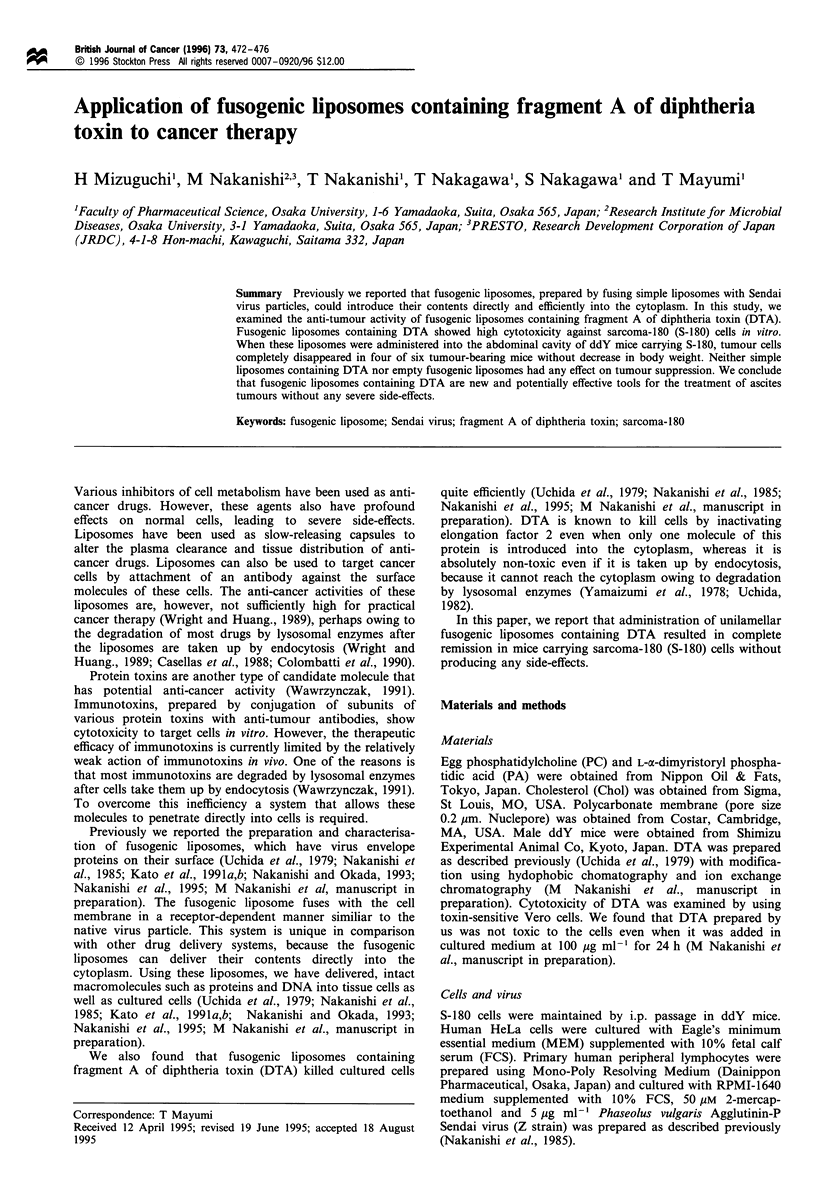
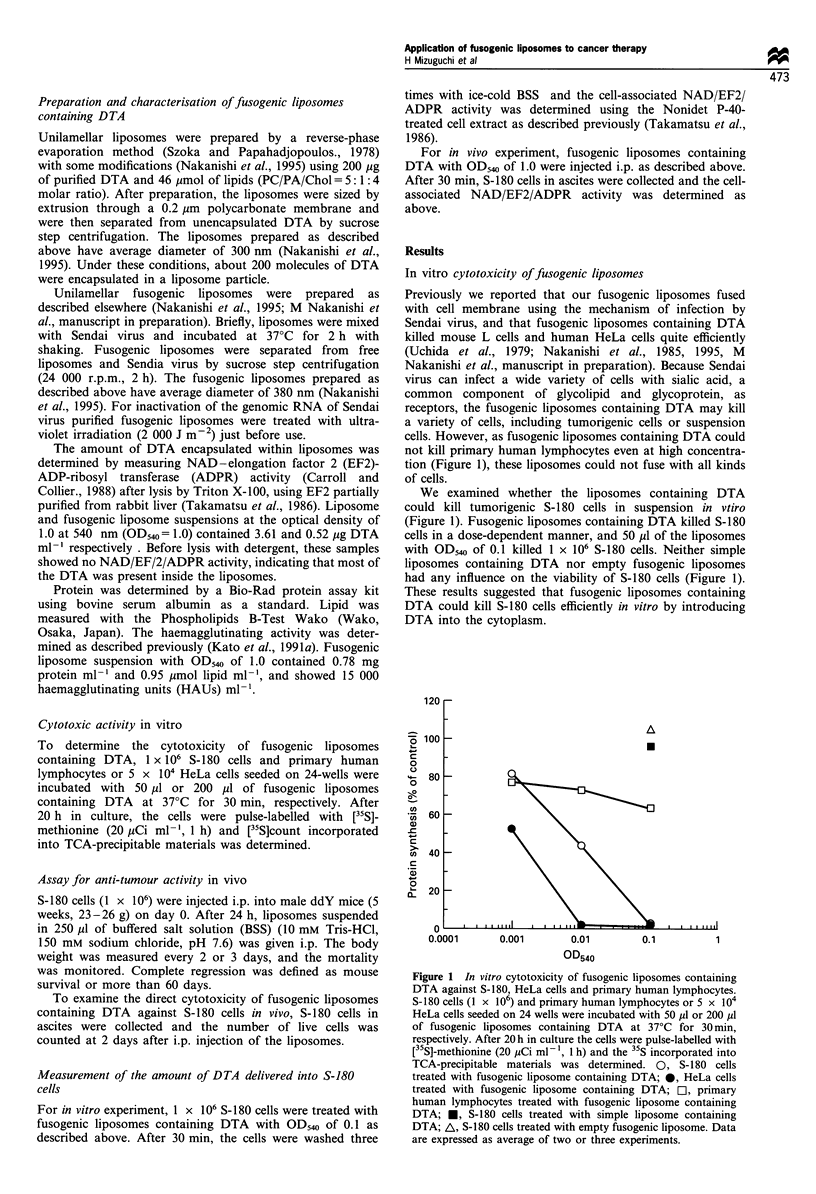
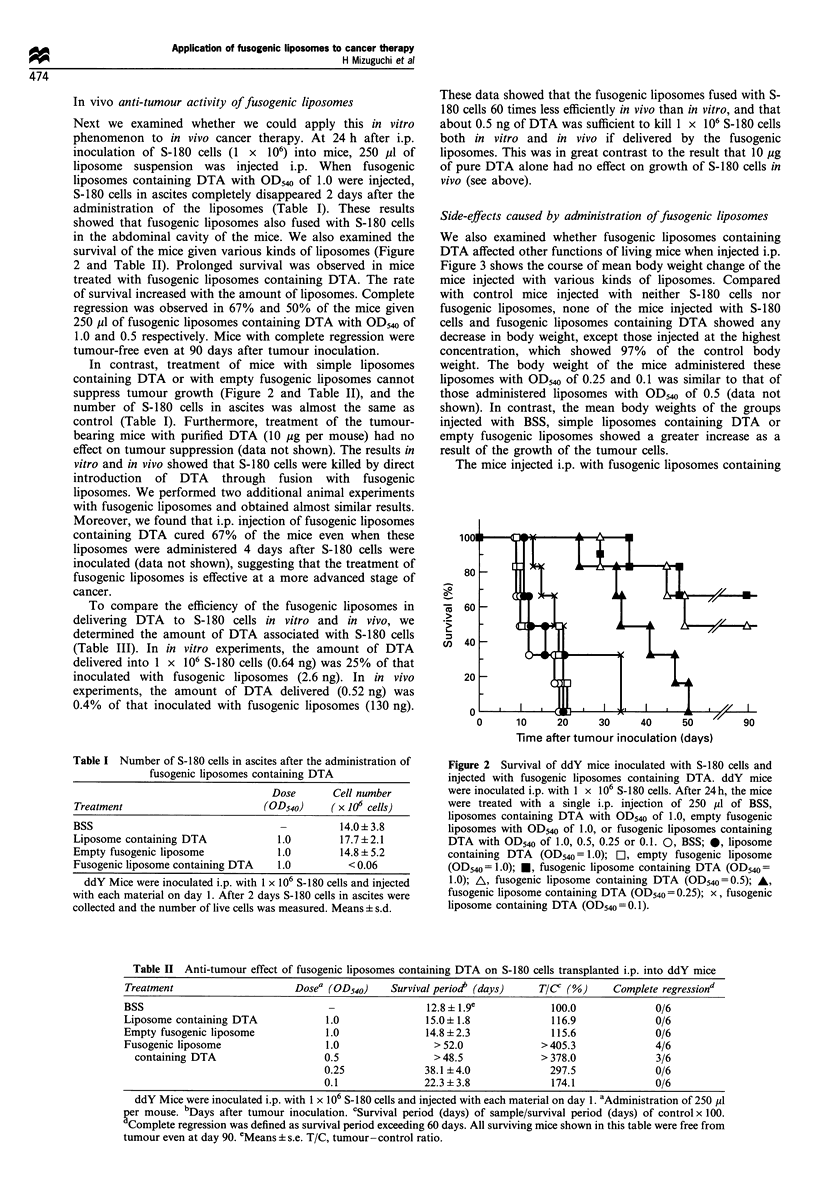
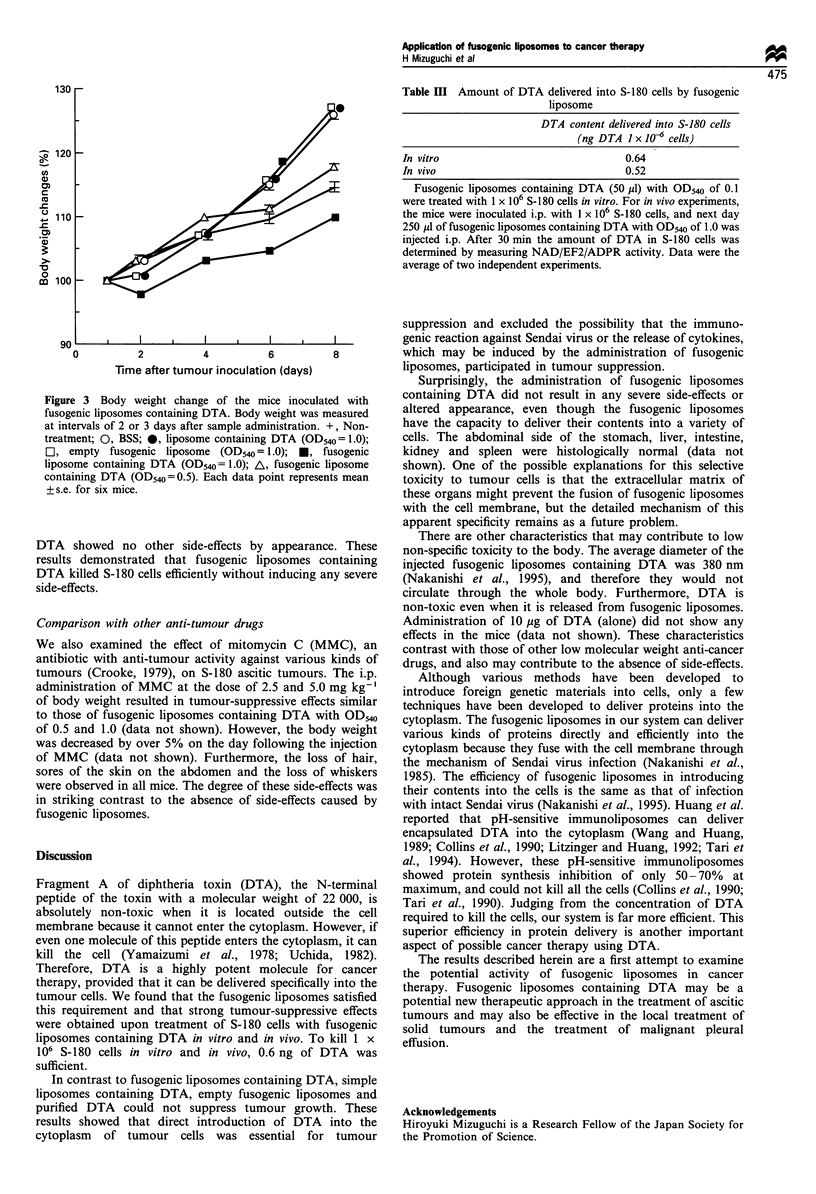
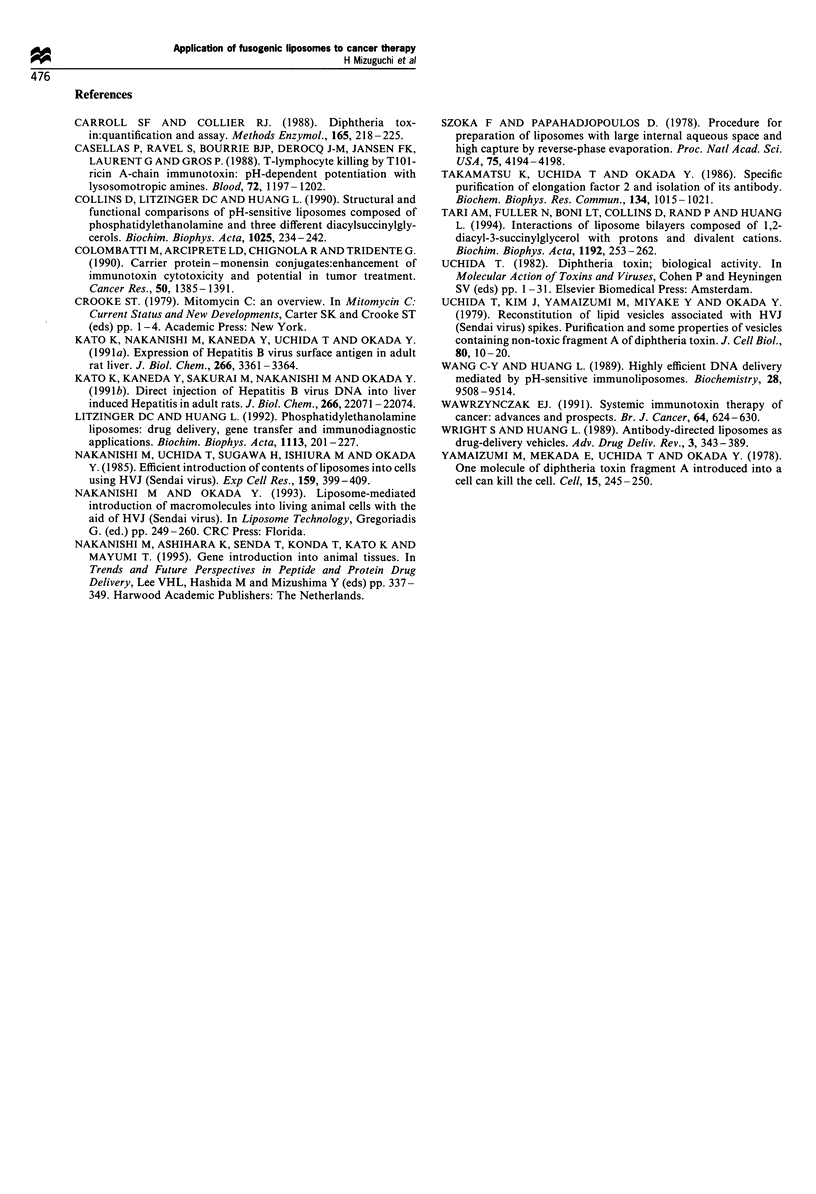
Selected References
These references are in PubMed. This may not be the complete list of references from this article.
- Carroll S. F., Collier R. J. Diphtheria toxin: quantification and assay. Methods Enzymol. 1988;165:218–225. doi: 10.1016/s0076-6879(88)65034-8. [DOI] [PubMed] [Google Scholar]
- Casellas P., Ravel S., Bourrié B. J., Derocq J. M., Jansen F. K., Laurent G., Gros P. T-lymphocyte killing by T101-ricin A-chain immunotoxin: pH-dependent potentiation with lysosomotropic amines. Blood. 1988 Oct;72(4):1197–1202. [PubMed] [Google Scholar]
- Collins D., Litzinger D. C., Huang L. Structural and functional comparisons of pH-sensitive liposomes composed of phosphatidylethanolamine and three different diacylsuccinylglycerols. Biochim Biophys Acta. 1990 Jun 27;1025(2):234–242. doi: 10.1016/0005-2736(90)90102-t. [DOI] [PubMed] [Google Scholar]
- Colombatti M., Dell'Arciprete L., Chignola R., Tridente G. Carrier protein-monensin conjugates: enhancement of immunotoxin cytotoxicity and potential in tumor treatment. Cancer Res. 1990 Mar 1;50(5):1385–1391. [PubMed] [Google Scholar]
- Kato K., Kaneda Y., Sakurai M., Nakanishi M., Okada Y. Direct injection of hepatitis B virus DNA into liver induced hepatitis in adult rats. J Biol Chem. 1991 Nov 25;266(33):22071–22074. [PubMed] [Google Scholar]
- Kato K., Nakanishi M., Kaneda Y., Uchida T., Okada Y. Expression of hepatitis B virus surface antigen in adult rat liver. Co-introduction of DNA and nuclear protein by a simplified liposome method. J Biol Chem. 1991 Feb 25;266(6):3361–3364. [PubMed] [Google Scholar]
- Litzinger D. C., Huang L. Phosphatidylethanolamine liposomes: drug delivery, gene transfer and immunodiagnostic applications. Biochim Biophys Acta. 1992 Aug 14;1113(2):201–227. doi: 10.1016/0304-4157(92)90039-d. [DOI] [PubMed] [Google Scholar]
- Nakanishi M., Uchida T., Sugawa H., Ishiura M., Okada Y. Efficient introduction of contents of liposomes into cells using HVJ (Sendai virus). Exp Cell Res. 1985 Aug;159(2):399–409. doi: 10.1016/s0014-4827(85)80013-6. [DOI] [PubMed] [Google Scholar]
- Szoka F., Jr, Papahadjopoulos D. Procedure for preparation of liposomes with large internal aqueous space and high capture by reverse-phase evaporation. Proc Natl Acad Sci U S A. 1978 Sep;75(9):4194–4198. doi: 10.1073/pnas.75.9.4194. [DOI] [PMC free article] [PubMed] [Google Scholar]
- Takamatsu K., Uchida T., Okada Y. Specific purification of elongation factor 2 and isolation of its antibody. Biochem Biophys Res Commun. 1986 Jan 29;134(2):1015–1021. doi: 10.1016/s0006-291x(86)80522-8. [DOI] [PubMed] [Google Scholar]
- Tari A. M., Fuller N., Boni L. T., Collins D., Rand P., Huang L. Interactions of liposome bilayers composed of 1,2-diacyl-3-succinylglycerol with protons and divalent cations. Biochim Biophys Acta. 1994 Jun 22;1192(2):253–262. doi: 10.1016/0005-2736(94)90126-0. [DOI] [PubMed] [Google Scholar]
- Uchida T., Kim J., Yamaizumi M., Miyake Y., Okada Y. Reconstitution of lipid vesicles associated with HVJ (Sendai virus) sikes. Purification and some properties of vesicles containing nontoxic fragment A of diphtheria toxin. J Cell Biol. 1979 Jan;80(1):10–20. doi: 10.1083/jcb.80.1.10. [DOI] [PMC free article] [PubMed] [Google Scholar]
- Wang C. Y., Huang L. Highly efficient DNA delivery mediated by pH-sensitive immunoliposomes. Biochemistry. 1989 Nov 28;28(24):9508–9514. doi: 10.1021/bi00450a039. [DOI] [PubMed] [Google Scholar]
- Wawrzynczak E. J. Systemic immunotoxin therapy of cancer: advances and prospects. Br J Cancer. 1991 Oct;64(4):624–630. doi: 10.1038/bjc.1991.374. [DOI] [PMC free article] [PubMed] [Google Scholar]
- Yamaizumi M., Mekada E., Uchida T., Okada Y. One molecule of diphtheria toxin fragment A introduced into a cell can kill the cell. Cell. 1978 Sep;15(1):245–250. doi: 10.1016/0092-8674(78)90099-5. [DOI] [PubMed] [Google Scholar]


